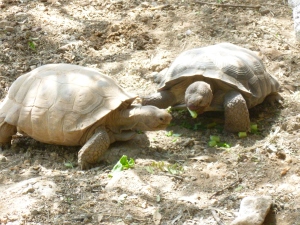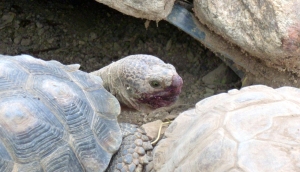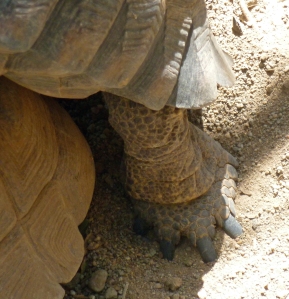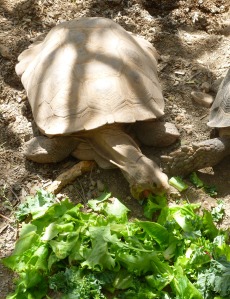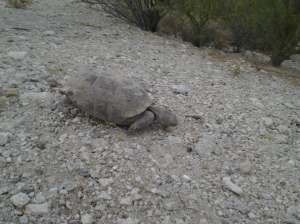Arizona Turtles, Tortoise - Do NOT pick up the Desert Tortoise unless it is in harms way. The Tortoise will get scared, release the water in its bladder and most likely die during the dry season.
It is also illegal and detrimental to the desert tortoise populations to collect tortoises from the wild.
Removing any of the Six species of Arizona’s native turtle / tortoise can severely affect local populations because they reproduce very slowly in natural conditions.
What is the difference between male and female Desert Tortoises, Turtles?
It can take up to 20 years before the Desert Tortoise Turtle starts showing physical characteristics that are typical of the 2 sexes. The sex of a tortoise is based on the temperature of the nest and NOT genetics.
One way to tell the difference between the female and male tortoise is by the tail. A male desert tortoise has a larger tail than the female. The female has a very short tail. Also, male tortoises have 2 chin glands that are enlarged during mating season. Sometimes a white gooey liquid comes out of the male tortoise chin glands.
The desert Tortoise is called – a living dinosaur.
TURTLES & TORTOISE facts:
Dinosaurs became extinct but turtles tortoise have thrived in their present form for approximately 150 million years.
The Desert Tortoise is one of four species that have remained unchanged since the Oligocene Epoch 27-37 million years ago.
Arizona Game and Fish Department’s TURTLE PROJECT works to manage and conserve all six species of turtles/tortoises. They receive hundreds of young and adult Tortoises that have been displaced due to construction or raised in captivity. The TURTLE PROJECT has Tortoises available for adoption.
A captive tortoise has to be raised in captivity for the rest of its life. A desert Tortoise can live up to a 100 years old!
If a captured tortoise is released in the wild it can introduce diseases and jeopardize the wild populations. URTD (an upper respiratory infection) has caused catastrophic die-offs in the Mojave tortoise population, resulting in Mojave Tortoise being placed on the federal listing under the Endangered Species Act.
If you are interested in Tortoises but are not in the position to adopt, you can still participate in the Sponsor-a-Turtle program. By donating to the Turtles Project, you will help project biologists purchase specialized gear so that they may continue to plan and implement conservation and management. Click here to download the Sponsor-a-Turtle program brochure.
A tortoise is a high-domed turtle, with “columnar” legs, or elephant-like. It is more terrestrial ( an animal that lives on land as opposed to water) than the turtle is, Arizona Tortoises go to water only to drink or bathe. They are NOT designed for swimming.
When the tortoise/turtle species emerges from winter torpor, brumation it will eat new growth cacti and their flowers, grasses, some shrubs.
** What is Brumation - it is different than hibernation; when mammals hibernate, they actually sleep; when reptiles brumate, their metabolism slows down making them less active, and so they just barely need to eat.
Reptiles can often go through the whole winter without eating. Brumation is triggered by lack of heat and the decrease in daylight hours.
A single tortoise may have a dozen or more burrows distributed over its home range. These burrows may be used by different tortoises at different times. Some of their burrows just extend beyond the shell of the tortoise inside.
The tortoise is able to live where ground temperatures may exceed 140 degrees F, because of its ability to dig underground burrows and escape the heat.
Image courtesy of AZ Game and Fish Dept. http://www.azgfd.gov/
Desert tortoises generally emerge from their burrows mid-March to feed. During a roughly six week period fresh green grass and spring wildflowers are their primary nutritional source.
In the Sonoran Desert of Arizona, the tortoises tend to live on steep, rocky hillside slopes in Palo Verde trees/shrubs and Saguaro Cactus areas.
The tortoise’s forelimbs are flattened with well-developed muscles for digging burrows and the hind limbs are elephantine in which the female tortoise uses to dig her nests.
Fighting may occur any time male tortoises encounter each-other. When fighting the desert tortoise/turtle will use the gular scutes to ram and flip other males. A flipped male will usually right itself after the defeat, but if it cannot, the turtles or tortoise will die.
The turtle shell is a highly complicated shield of the tortoise, completely enclosing all the vital organs and in some tortoise/turtle species even the head.
Helping to make the desert tortoise suited for desert-life is the ability to acquire almost all of its water from the plants that it eats. Because desert tortoises live in an arid climate where most of the rainfall occurs during the monsoons, the Tortoise is able to store water in its bladder for use during drought.
Adult tortoises have very few natural predators because of its thick, scaly skin and hard shell. In the Sonoran desert, mountain lions are the main predators of adult desert tortoises. Worse than predation, however, is the pressure the species is under from development, the construction of roads, and other human activities that degrade its habitat and cause mortality.
Courting, mating and copulation may occur any time that tortoises are above ground; however, there seems to be more of this behavior in late summer and early fall when the testosterone levels peak in male tortoises.
Females store sperm and egg laying occurs in May, June and July.
A mature female tortoise might lay 4-8 white, hard-shelled eggs in a clutch and produce 2, sometimes 3 clutches in a season. Only a few tortoise eggs out of every hundred actually make it to adulthood.
After laying, the female tortoise leaves the nest and the soil temperatures support growth of the embryos. Incubation periods of 90 to 120 days.
Slow growth and soft shells make baby tortoises particularly vulnerable to predators.
Filed under: Arizona Wildlife, Colossal Cave Mountain Park, Desert Plants, Desert Tortoise/Turtle, Endangered Species, Free Pictures, Tucson Tagged: adopt a tortoise, Arizona Tortoise, arizona tortoise program, arizona turtle, baby tortoise, brumation, desert animals, desert tortoise facts, desert tortoise tucson, Desert Tortoise/Turtle, Desert Turtle, desert turtle arizona, difference between female male desert tortoise turtle, endangered tortoise, female desert tortoise, Free Pictures, living dinosaurs, male desert tortoise, male female tortoise, Sonoran Desert, Sonoran Tortoise, tortoise, tortoise at colossal cave, tortoise den, tortoise facts, tortoise hatchlings, tortoise hibernate, tortoise sleeping, turtle, walking dinosaurs, what tortoise eat, where are desert tortoise, wildlife
